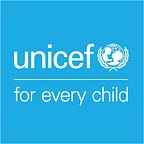In harm’s way
Hundreds of ceasefire violations continue to put children’s physical safety and overall well-being at risk in eastern Ukraine
In 2017 as the volatile conflict in eastern Ukraine enters its fourth year, 1 million children are in urgent need of humanitarian assistance. The situation is particularly grave for the approximately 200,000 girls and boys living within 15 kilometres on each side of the so-called contact line, which divides government and non-government controlled areas where fighting is most severe.
Nina holds her granddaughters (left) Diana, 14, and (right) Sasha, 6, outside her house which is some 15 kilometers from the contact line in Toretsk. The girls have lived with their grandmother since 2014 because the parents believe it is safer than living with them in Donetsk.
(Left) Sasha, who is in the first grade, completes her homework with the help of her sister Diana, who is in ninth grade. Despite the ongoing armed conflict and 1 in 5 schools in eastern Ukraine having been damaged or destroyed, schools remain open and classes start on time.
Sasha (centre) carries an empty bottle as she goes to collect water from a well on the outskirts of the village with her grandmother Nina (left) and sister Diana. Access to water is a challenge for many communities in eastern Ukraine.
(Left) Diana pours hot tea for Sasha on a cold winter day. At first their parents visited once a week, but checkpoints mean the journey between Toretsk and Donetsk is difficult and expensive.
“I would like the shooting to stop, and I want to see my mother and father,” says Sasha.
(Right) Sasha is held by Diana (centre) alongside their grandmother Nina in the cellar of the house where they shelter when there is shelling.
According to Nina “the windows tremble during the shelling and every time you think: I hope it doesn’t hit us.”
Sasha carefully ascends the steps leading out of the cellar where they shelter when there is shelling. Along the contact line, some 19,000 children face constant danger from landmines and other unexploded ordinance and 12,000 children live in communities shelled at least once a month
(Centre) Sasha and other first grade students take part in a practice drill to prepare in case of shelling at Toretsk school №20. Because there is no basement which could serve as a shelter, the students are taught to assemble in a part of the school with strong walls.
Sasha (in red sweater) and other first grade students attend a class in Toretsk school №20. Hundreds of daily ceasefire violations put children’s physical safety and psychological well-being at risk. More than 740 schools in eastern Ukraine have been damaged or destroyed.
Diana writes in her notebook during a class in Toretsk School №20. While Diana and her sister Sasha face many challenges, the fourteen-year-old hopes one day to become a teacher — much like her grandmother, who teaches physics.
Sasha (in red sweater) and other students perform exercises before a class in Toretsk School №20. Teachers, psychologists and parents report signs of severe psychosocial distress among children including nightmares, aggression, social withdrawal and panic triggered by loud noises.
Learn more about the situation in Eastern Ukraine and how that impacts on children — Sirens and bomb shelters:Going to school in eastern Ukraine.
